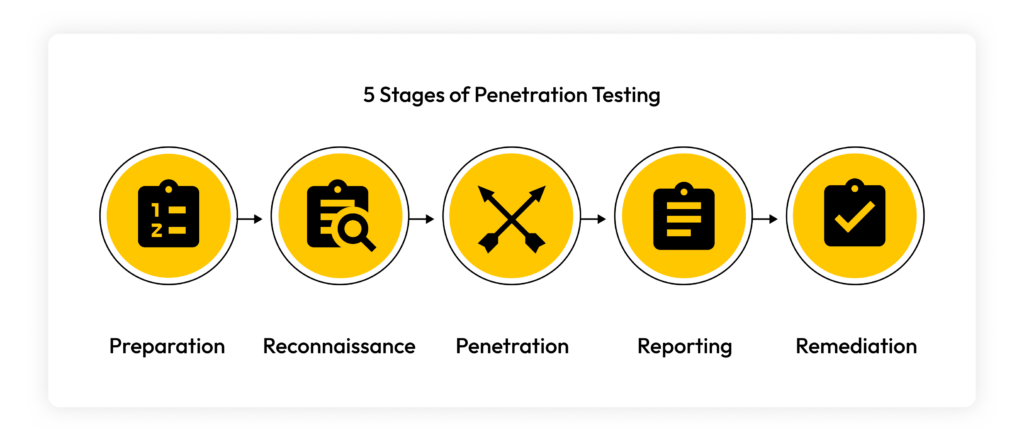The main difference between an attack vector and an attack surface is that an attack vector is the specific way a cybercriminal can take advantage of
You can run a penetration test by following the five stages: preparation, reconnaissance, penetration, reporting and remediation. Penetration tests are important to help protect an organization from security breaches and data leaks. Cybercriminals are always looking for vulnerabilities within an organization’s system to steal their sensitive data. Penetration testing helps organizations identify security vulnerabilities to help prevent security breaches.
Continue reading to learn more about penetration testing, the benefits of running one, the five stages of penetration testing and the different methods of penetration testing.
What Is a Penetration Test?
Penetration testing, also known as pen testing or ethical hacking, is a security exercise that simulates a cyber attack on an organization’s systems. This simulation evaluates the strength of the organization’s security and identifies any security vulnerabilities that cybercriminals could exploit. These security vulnerabilities include unpatched devices, application flaws, misconfigured networks or careless end-user behavior.
White hat hackers are ethical hackers who team up with organizations to test their security defenses and response against cyber attacks. They use malicious techniques such as brute force, social engineering or web application attacks to attack an organization and exploit vulnerabilities that exist.
There are three categories that penetration tests fall into:
- Black box testing: White hat hackers have no knowledge or understanding of the target’s systems, similar to most threat actors. This type of penetration test is the quickest test and is used to identify external and easy-to-exploit vulnerabilities.
- Gray box testing: White hat hackers have some knowledge of the target’s systems and security measures. This type of penetration test tries to find any internal vulnerabilities that can be exploited.
- White box testing: White hat hackers have extensive knowledge of all of the target’s systems, technology and entire security infrastructure. This type of penetration testing takes the longest as it tries to find the tiniest flaws.
Benefits of Penetration Testing
Penetration testing gives organizations full visibility into their security infrastructure and can determine how well organizations protect their sensitive information from cybercriminals. It helps them identify what aspects of their cybersecurity are working and what they can improve upon. Here are the benefits of penetration testing.
Test security strength
Penetration testing helps an organization get a better understanding of its security infrastructure. It tests the strength of the organization’s security measures. Penetration testing helps organizations find out what security protocols are working and what vulnerabilities cybercriminals can use to exploit. With penetration testing, organizations can determine how well their security system responds to cyber attacks and how well it can prevent them.
Prevent security breaches
Security breaches are when unauthorized access to sensitive data, applications, networks or devices occurs. Security breaches can result in the loss of sensitive data and money. By identifying and removing security vulnerabilities found within an organization’s network, the organization can protect its data and prevent future security breaches from happening.
Adhere to regulatory and industry compliance frameworks
Penetration testing helps organizations adhere to regulatory and industry compliance frameworks such as PCI DSS, SOX, GDPR and HIPAA. Penetration testing helps organizations maintain compliance and protect sensitive data.
The 5 Stages of Penetration Testing
The five stages of penetration testing are preparation, discovery, penetration, reporting and remediation. Here is a closer look at each of the stages of running a penetration test.

Stage 1: Preparation
The preparation stage defines the scope of the penetration test. The organization determines what will be tested and the goal of the test. They will determine what category of penetration testing will be conducted and the methods used. The organization will then gather the white hat hackers needed for the test and go over the parameters of the test with them.
Stage 2: Reconnaissance
During reconnaissance, the white hat hacker gathers information about the target, such as their network and domain names, to better understand the target’s security system. They use scanners to find any vulnerabilities that will allow them access to the system. Once the white hat hacker finds vulnerabilities within the target’s systems, they determine the techniques that will be used to exploit those vulnerabilities.
Stage 3: Penetration
The penetration stage exploits the vulnerabilities found during the reconnaissance stage. White hat hackers try to penetrate the target’s network and gain unauthorized access. They use tactics such as cross-scripting, SQL injection or phishing to gain initial or further access to the network. White hat hackers tend to exploit multiple vulnerabilities to gain as much access to the network as possible. Once the white hat hackers have gained access, they try to remain undetected for as long as they can and steal as much data as they can.
Stage 4: Reporting
After the penetration stage, the white hat hacker will report on their findings from the test. They provide the organization with a summary report of the penetration test, a list of vulnerabilities that were found, a list of vulnerabilities that were exploited, how long they maintained access undetected and what sensitive data they managed to access.
Stage 5: Remediation
At the final stage of penetration testing, the white hat hacker restores the compromised system and resources to their original state to ensure the organization can still operate. Once the system has been cleaned up, the organization can implement patches and updates to mitigate any security vulnerabilities. The organization should then re-test to ensure the security vulnerabilities were properly remedied.
Penetration Testing Methods
The penetration testing method an organization uses depends on the results they are looking for. Each penetration testing method can garner different results and show different levels of security within an organization. Here are the different penetration testing methods organizations can use.
External testing
External testing tries to find vulnerabilities using outside attack sources. White hat hackers try to attack public assets of the organization such as websites, applications, emails and domain name servers. They try to exploit vulnerabilities found within these assets to access and steal sensitive information from the organization.
Internal testing
Internal testing tries to simulate a situation where the threat actor has internal access to the organization’s systems, for example, as a result of insider threats such as careless employees who revealed their login credentials during phishing attacks. It tries to determine the damage that can be done from internal attacks.
Blind testing
Blind testing is when the organization knows about the simulated cyber attack and can prepare for it, but the white hat hacker has only public information about the target to gain unauthorized access. This helps simulate how a real cyber attack would look from the white hat hacker’s perspective. Typically, cybercriminals have limited information about their target, and blind testing helps show how a cybercriminal would attack an organization.
Double-blind testing
Double-blind testing is when both the organization and the white hat hacker have no information about the simulated attack. The organization doesn’t know that the attack is happening. The white hat hacker does not have any insider information about the target and must rely on their skills to get into the target’s network. This helps simulate a real cyber attack from both perspectives. If the white hat hacker gets into the organization’s systems, then the organization needs to patch any vulnerabilities that are uncovered. If the white hat hacker fails, then the organization’s security systems are ready for a real attack.
Strengthen Your Cybersecurity With Penetration Testing
Running a penetration test of your organization’s security systems is necessary to ensure the strength of your organization’s security, prevent security breaches and adhere to regulatory compliances. You can identify any security flaws and protect your organization’s sensitive data. You can partner with a penetration testing organization such as the NCC Group or with your own cybersecurity team to run a penetration test. Your organization should run penetration tests often to ensure your security infrastructure is up to date and best protected against cybercriminals.
 Cybersecurity
Cybersecurity 
